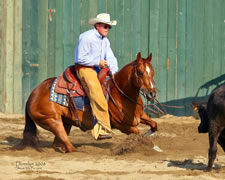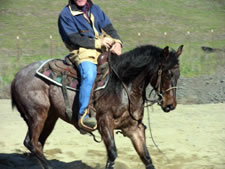
|
BALANCE: THE DEMYSTIFIER Have you ever heard from your trainer, instructor or some other horseperson, "Try doing this with your horse, but don't ask me why it works." If it did work, if the horse "got it", then balance was the ultimate reason. And training with balance in mind can demystify the educational process for both you and your horse. The success of any technique, "trick," program, or piece of training equipment depends on whether or not it helps the horse to find the balance necessary to deliver the desired result. When my horses don't understand me, the first question I ask is "Have I shown this horse how to get his balance so that he can do what I am asking him to do the way I need him to do it?" Reining horses obviate the fundamental role balance plays in the horse's ability to understand and perform. Correct and willing spins, slides, circles, etc. require incredible balance, especially as we ask for more speed and hand more responsibility to the horse to respond immediately to more subtle signals. But balance is critical to every horse at every stage of its development. Perhaps only secondary to being eaten or attacked, horses are most afraid of falling down (just think of how vulnerably placed their heads are). Ignoring this instinctive fear can create problems from stalled progress to chronic resistance to injury to out right panic. On the other hand, if we pay attention to how any individual horse prepares to use its body, how it balances itself, we can build on its natural abilities or offer it more efficient and therefore less risky ways to handle our requests. First attempts at picking up feet, jumping into a trailer, carrying a rider, moving from trot to canter are some everyday examples that can go well or poorly depending on our willingness to give our horses time to adjust their balance. For reining and other sport horses we gravitate toward natural athletes. Even these horses grow up with certain asymmetries and habitual ways of doing things that may create challenges as we start to handle and ride them. Whether started or not, when a new horse comes to my barn, the first thing I do is turn it out in the arena and watch it move. Within minutes of observing how it stops, turns, and makes transitions, certain patterns will become obvious. Often, for example, the left hind leg will show a little less reach and elasticity, making the right canter lead unlevel and harder for the horse to obtain without compensating or stiffening somewhere else. The horse may also show less willingness to stop and roll back to the left and more willingness to turn toward me and expose his left side. I can use the latter but I'll have to help him with the former. When I start this horse I'll look for ways to encourage that left hind to reach a little further, helping him stay balanced and more relaxed and ready. Often this means changing his habitual responses by slowing down, directing him toward other options, and waiting for his feet to adjust. Tying his head around to the left and encouraging him to walk forward then stop and turn to the left is one of many tools we use in this instance. It works not by forcing the horse to yield his nose, but rather by putting the horse in a position by which he can learn a new way of getting his balance and thereby soften his left side. Using his left hind more, he can transfer weight off his front end and use his neck and rib cage more athletically. This balance shift and subsequent suppleness in turn allows him to place his front feet to make the turn rather than avoid it. Later he will be more willing to put these body parts at my disposal and not feel he has to protect himself from losing his balance by resisting or leaning on me. By showing him how to get balanced, I make taking direction easier for him, preempt resistance and begin to establish the belief that he can trust me to show him the easy way. The real point here is to look at causes rather than symptoms. Balance or lack thereof causes the horse to respond to our instruction well or poorly. Over the centuries experts have taught us that under saddle a straight, level horse is in the optimal position to engage its hind quarters and carry the rider without resistance. In reining this translates into balanced stops, turns, circles and changes of leads. To advance a horse toward those maneuvers we educate him to yield his various body parts but sometimes lose track of whether these suppling exercises or the way we ride them are contributing to straightness, levelness and the ability to engage - the kes to balance. We criticize resistance or dullness as misbehavior or clumsiness without recognizing the lack of balance that is causing it. The maneuvers suffer as does the horse's willingness to perform them. For example, we commonly use some version of a half pass to supple and advance a reining horse. We ask the horse to bend or flex, say to the right, as we drive his haunches to the right. The immediate objective is to gain control of the left hind leg while keeping the horse soft in the ribs, back and poll. Once we can do this without resistance in both directions, we should be able to dispense with the bend and collect the horse while keeping him straight. At first he may resist the exercise, leaning on our hands like a fifth leg. And we may be tempted to increase the pressure and lateral flexion. But if we remember that balance through straightness is the ultimate objective and that the controls are just a means to that end, we can help him understand by releasing the flexion as soon as the haunches move right and then walking straight forward from where the haunches now are (head, shoulders and haunches all in a line). He will extend his reach from behind, level and lighten his shoulders and learn that our manipulations of his body increase rather than risk his balance. The next time we ask he will sustain the exercise longer with less resistance. If, however, we do not allow the horse to straighten when he yields his hind end (by increasing the flexion or by riding him out of the flexion in a circle to the right for example) he will load weight to and extend the right foreleg, causing his left hind stride to shorten and disengage. Instead of preparing the horse, the exercise ends up working against confidence, lightness and ability. When a new student hauls their own horse into me for a lesson I usually leave them alone in the arena to warm up. Frequently, I come back to find them in a tussle while loping a circle, complaining that the horse is "dropping a shoulder." The rider is sitting to the outside of the horse, pulling the horse's nose to the inside and trying to push the horse's shoulder up and out of the circle. Often the horse is steering like a truck and building speed or trying to break gait. A little chat usually reveals that the problem isn't new and that both the horse and rider are running out of patience. By focusing on the shoulder, the rider has lost track of the origin of the problem and embarked on the exact opposite solution from what the horse needs. First and most importantly, the rider needs to maintain a position in the middle of the horse (with his inside seat bone down and forward) so that the horse doesn't have to lean in to counterbalance the rider's weight. Second, rather than bend the horse's neck to the inside, he should let the horse straighten out or even counter flex the horse, encouraging his outside hind leg to stride further underneath him to support the canter. Then and only then will the horse be able to lighten, elevate, and level his front end enough to submit to whatever flexions or shoulder control exercises the rider may deem necessary. Once allowed to regain his balance, the horse will gain confidence, suppleness, responsiveness and guidability. Go to any reining and look closely at the horse rider combinations that make it look easy. At the best shows the horses will be naturals and the riders very talented horsemen. But you will see that the horses that perform willingly with authority, quickness, grace and calm are also those with the most centered riders. These riders can communicate more accurately with their hands, legs and seat and do not force the horse to struggle for his balance. Riding from a balanced position and with the horse's balance in mind their training techniques at home may be less forceful and contrived as well. Lowering a horse's neck, for example, especially in run downs and turn arounds has almost become a goal in itself, with a host of approaches and devices designed to do just that. The intent here is to give the rider more access to the horse's hind quarters by creating a softer poll and a rounder, more supple back. But an elevated neck or hollow back is often symptomatic of an off balance horse and rider. The horse stiffens to protect himself. Focusing on the neck without addressing the balance necessary to support a lower position will only elevate the rear end and drive the front end further into the ground. The horse may then develop such habits as dropping his shoulders in the stop or becoming unlevel and clumsy in the turn around. The rider in turn may resort to remedial fixes like driving shoulders to one side after the stop or bumping a horse's nose to bring it's inside front foot back out of the way in the spin. If the rider's timing is right on, a talented horse may find its balance from these corrections; but many will lose confidence and desire to execute the maneuver. We can do a lot to avoid this downward spiral by giving the horse his hind quarters first, asking each hock to move up underneath him, thereby lowering the rear end with respect to the shoulders. From this balanced position, the back will soften and the neck will lower as needed. The correct execution of any given maneuver then becomes comfortable, easy and, once the signals are in place, inevitable. And in the end, eliminating the guess work for ourselves and our horse is what it is all about. Whether dressage, reining, working a cow, or just riding a well broke horse is our goal, we want to know that our horse will get us there every time we ask. Our obligation is to give him the tools he needs to remain willing and able. So when we open our bag of tricks it helps to select our approach based whether it will allow or encourage the horse to feel balanced and capable of carrying himself and us. |
|||
|

|
Member Bay Area Equestrian Network |
Site designed, hosted and maintained by Bay Area Equestrian Network. ©Copyright 2010-2024 Thomas Ranch. All Rights Reserved. |
|







